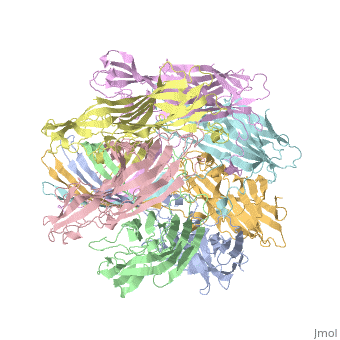Hemolysin
FunctionHemolysin (HL) is exotoxin from bacteria which causes lysis of red blood cells[1]. Hemolysin from the bacterium Clostridium are called alpha-toxin (AT). AT is a zinc metalloenzyme and binds to the membrane in the presence of calcium. It acts as a phospholipase C. See details for α-hemolysin in Pore forming toxin, α-hemolysin. See details of hemolysin E in Molecular Playground/ClyA. For toxins in Proteopdia see Toxins. RelevanceHL acts as a virulence factor in the pathogenesis of invasive infections[2]. |
| ||||||||||
3D Structures of hemolysin3D Structures of hemolysin
3D Printed Physical Model of Hemolysin3D Printed Physical Model of Hemolysin
Shown below is a 3D printed physical model of Hemolysin. The model is shown in alpha carbon backbone format with each chain colored uniquely.
The MSOE Center for BioMolecular ModelingThe MSOE Center for BioMolecular Modeling

The MSOE Center for BioMolecular Modeling uses 3D printing technology to create physical models of protein and molecular structures, making the invisible molecular world more tangible and comprehensible. To view more protein structure models, visit our Model Gallery.
Updated on 10-May-2018
A full page in Proteopedia exploring 7ahl is found here.
- β-hemolysin
- γ-hemolysin
- δ-hemolysin
- 2kam – SaHL-δ - NMR
- Hemolysin
- 3o44 – VcHL residues 161-741 – Vibrio cholerae
- 1xez – VcHL (mutant)
- 3a57 – HL 2 – Vibrio parahaemolyticus
- 3hvn – HL (mutant) – Streptococcus suis
- 3fy3, 5keh, 5kf3, 4w8q – PmHL A residues 30-265 – Proteus mirabilis
- 5sz8, 5kkd, 4w8r, 4w8s, 4w8t - PmHL A residues 30-234 (mutant)
- 1mt0 – EcHL B ATP-binding domain – Escherichia coli
- 5c21, 5c22 - EcHL D residues 57-333
- 2wcd – EcHL E residues 2-303 – Escherichia coli
- 1qoy, 4pho, 4phq - EcHL E (mutant)
- 2oai, 2r8d – HL corc_hlyc domain – Xylella fastidiosa
- 2r2z – HL residues 346-435 – Enterococcus faecalis
- 4wx3, 4wx5 - HL – Grimontia hollisae
- 3o44 – VcHL residues 161-741 – Vibrio cholerae
- Alpha-toxin
ReferencesReferences
- ↑ Mestre MB, Fader CM, Sola C, Colombo MI. Alpha-hemolysin is required for the activation of the autophagic pathway in Staphylococcus aureus-infected cells. Autophagy. 2010 Jan;6(1):110-25. PMID:20110774
- ↑ Nizet V. Streptococcal beta-hemolysins: genetics and role in disease pathogenesis. Trends Microbiol. 2002 Dec;10(12):575-80. PMID:12564994


